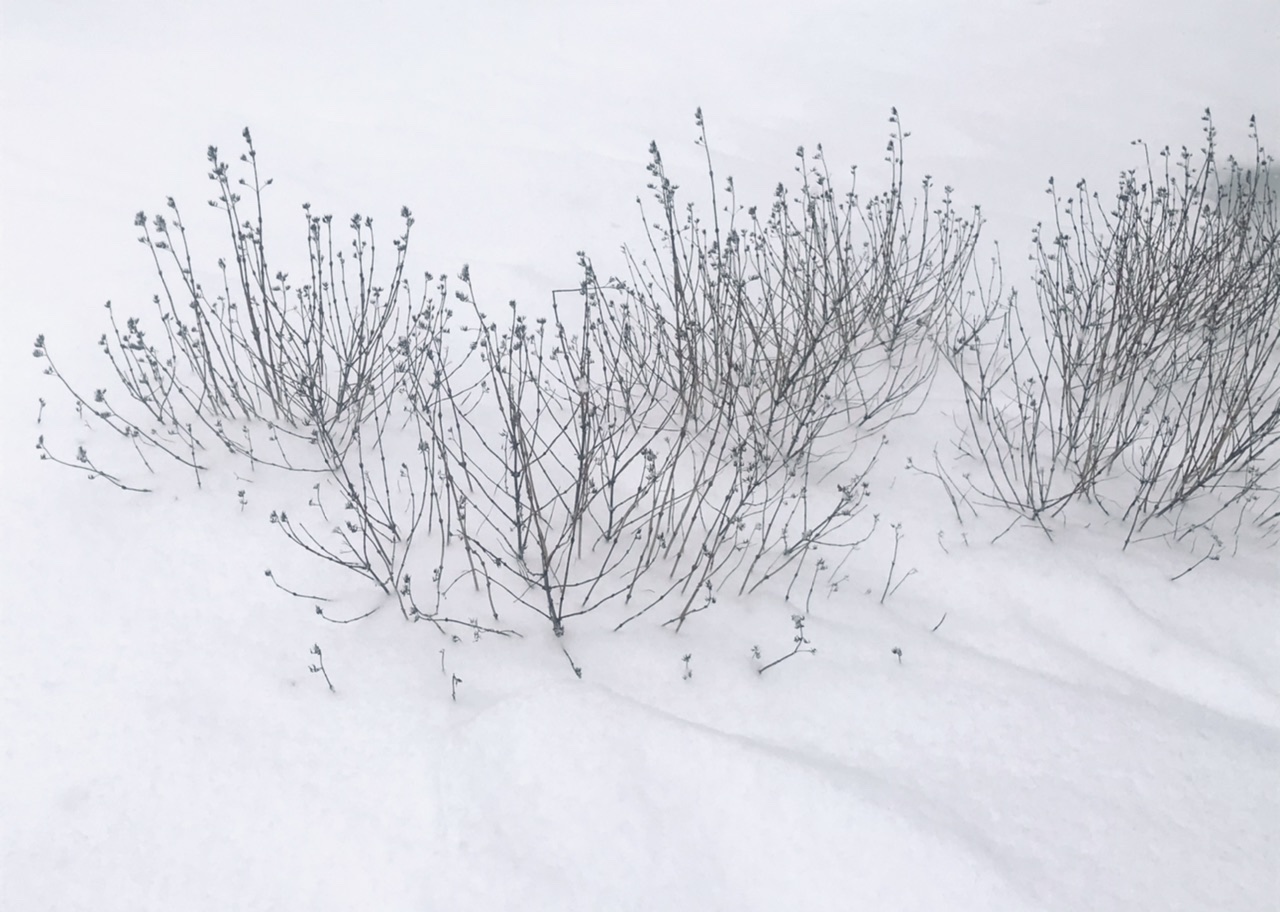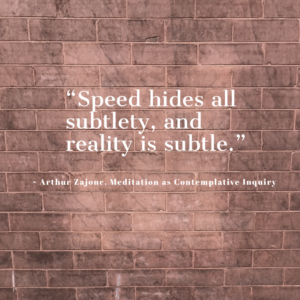
There were two books I read in 2020 that offered new meditative practices. The first, Meditation as Contemplative Inquiry by Arthur Zajonc, I wrote about previously (Part 1 and Part 2) and the second is A Path of Encounter by Jon McAlice. He argues that any type of meditation or contemplative practice first requires patience. Progress is gentle and steady, and sometimes hard to see. I’ve found this the case with my own daily meditation practice. It seems to be a time when I watch the activity of my very busy mind. And that’s okay. Making connections and seeing from a higher plane will arise on their own time. Nothing can be forced. Towards the end of McAlice’s book there are two sections on the value of slowness and silence, which seems particularly apt for these times.
What if you took some time to slow down, to take stock, to be still? What might you see?
 McAlice invites us slow down, to savour, enjoy the moment, be attentive to the unexpected. Why? Because busyness has a reactive quality, while slowness has an element of openness that invites responsiveness rather than reaction. If you look too quickly, you might miss the surprises, and only see what you’re expecting. rather than discover new opportunities and possibilities. Carefulness for the little things. This grounds us in the present.
McAlice invites us slow down, to savour, enjoy the moment, be attentive to the unexpected. Why? Because busyness has a reactive quality, while slowness has an element of openness that invites responsiveness rather than reaction. If you look too quickly, you might miss the surprises, and only see what you’re expecting. rather than discover new opportunities and possibilities. Carefulness for the little things. This grounds us in the present.
Why do many of us find it so difficult to slow down? I’ve attended meditation retreats where we practice slow walking, and I mean very slow, painfully slow. It’s an effective exercise to bring you into the moment because it requires so much concentration. We’re so used to wanting to get somewhere! Even harder is sitting and doing nothing. It’s just counter-cultural. I’ve asked photographers to sit and observe for fifteen minutes before picking up the camera. And they always tell me how hard it is for them. Slowing down takes practice.
McAlice says that people generally have either of two approaches when walking in nature (this is particularly relevant to photographers). Some zig and zag, exploring what catches their fancy, and staying at promising spots longer. Others slowly wander, noticing everything with equanimity – taking in everything as equally worthy. They stop and look closely along the way. Amidst the rubble, they find gems. Which type are you? Maybe a bit of both, but you probably lean one way.
In his book of delights, Ross Gay writes of the concept of loitering, which has a negative connotation, especially for people of colour.
“The Webster”s definition of loiter reads thus: to stand or wait around idly without apparent purpose and to travel indolently with frequent pauses. Synonyms are linger, loaf, laze, lounge, lollygag, dawdle, amble, saunter, meander, putter, dilly dally, and mosey. Any one of these words, in the wrong frame of mind, might be considered critique or, nouned, an epithet. All of these words to me imply having a nice day, the best day. They also imply being unproductive. Which leads to being, if only temporarily nonconsumptive, and this is a crime in America. … Another synonym is taking one’s time, which alludes to the ownership of one’s time.”
Can you take time to loiter or, at least, linger awhile? Bring your attention to those in between times – as you’re drinking your coffee, walking from one room to another, or just pausing from your work. Notice the details around you, without judgment. This creates the capacity to be receptive and to let go of needing a particular outcome. It’s challenging, yes, but can also lead to surprising, joyful moments, and to delights otherwise missed. Be patient with yourself. This is not easy to do if you’re a hyperactive person. Think of it as allowing something new to emerge. Also, it takes some of the responsibility off your shoulders to “make something happen.” It’s a way of trusting life.
Slowing down opens up space and in that space there is silence. McAlice writes,
“Inner peace, inner quiet, intentional silence is something one must attain before any meditative path can begin to lead to true experience. It is only in silence that the spirit can be heard. Silence is not an absence of sound but a state of soul. The soul that quiets itself and opens a space of receptive silence finds itself immersed in a world of previously unimagined possibilities of growth and transformation.”
McAlice recommends starting small by finding pockets of silence in your day. I’m committed to a minimum of ten minutes a day of meditation. Or, find a quiet place in nature or in your backyard or looking out the window. Sit quietly and be silent for two minutes, then five. Let sounds wash over you. Restrain your inner voice. Neither listen nor not listen. Neither see nor not see. Feel the quietness and peacefulness. Or, in your daily life, refrain from speaking without withdrawing from a conversation. There are many ways to be silent.
If you’re going through a stressful time – whether due to your job, raising children, grieving a loss, or just general anxiety – with little personal time, I understand that this may seem impossible. Do the best you can to find small moments just to stop and take a deep breath. If you’re confined to home, try to balance your doing – whether cooking and cleaning, finding activities for your children, working from home, watching Netflix, or scrolling social media – with practices of slowing down and being silent.
I found this to be particularly helpful in 2020 and what came up for me was that I (and maybe others too) needed ways to see clearly and discern truth. This led to my Seeing Clearly project for 2021. You’re welcome to subscribe (for free) at any time to the weekly email and/or review the archive so far.
Unusual times may bring new opportunities if you’re open to seeing them.